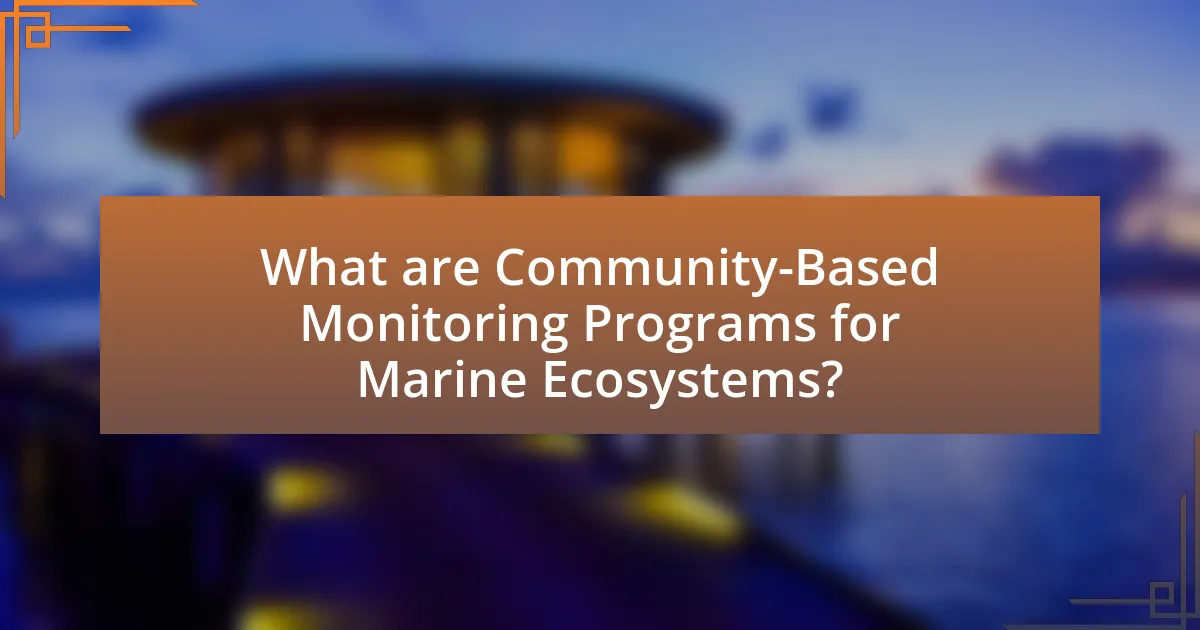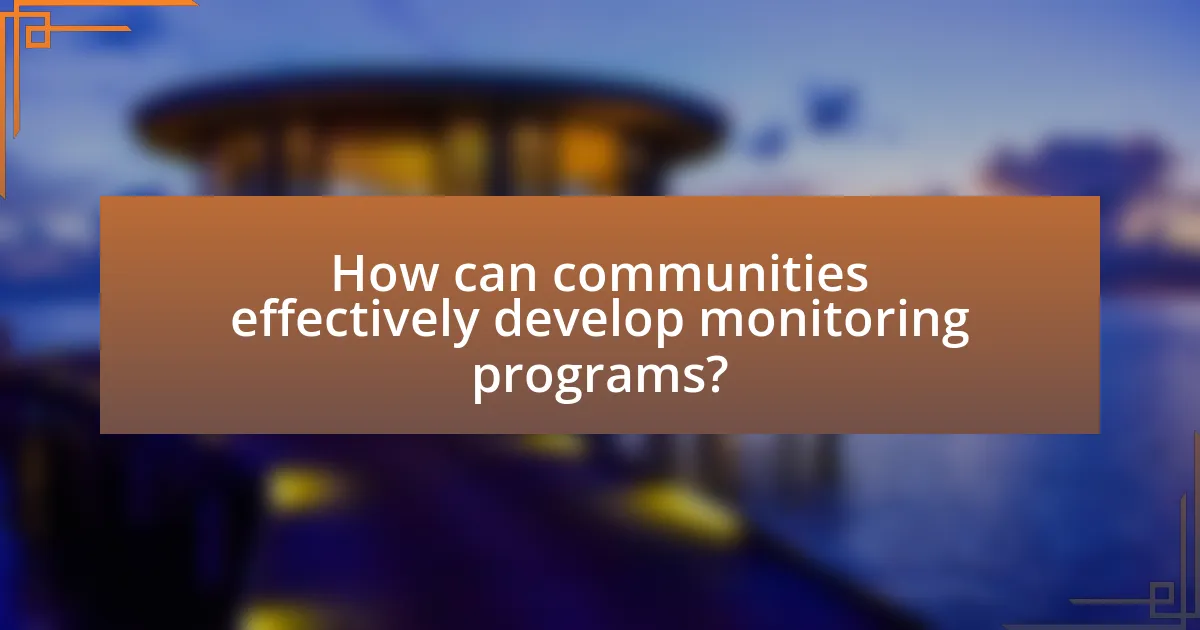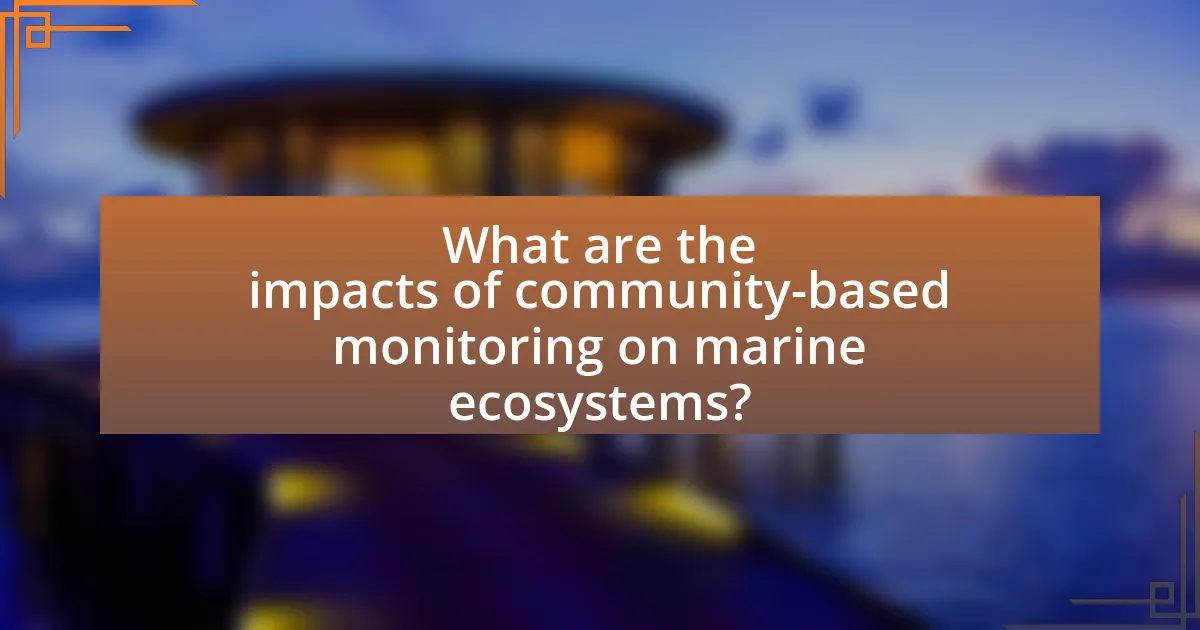Community-Based Monitoring Programs for Marine Ecosystems are initiatives that involve local communities in the observation and assessment of marine environments, enhancing conservation efforts through local stewardship and awareness. These programs empower community members to collect data on marine biodiversity, water quality, and ecosystem health, utilizing both traditional ecological knowledge and scientific methods. Key components for effective implementation include stakeholder engagement, capacity building, and the use of standardized data collection methods. Challenges such as limited funding and technical expertise can be addressed through collaboration and training, ultimately leading to improved marine resource management and policy influence. The article outlines methodologies, roles of community members, and best practices for developing successful monitoring programs that contribute to marine conservation.

What are Community-Based Monitoring Programs for Marine Ecosystems?
Community-Based Monitoring Programs for Marine Ecosystems are initiatives that engage local communities in the systematic observation and assessment of marine environments. These programs empower community members to collect data on marine biodiversity, water quality, and ecosystem health, often utilizing traditional ecological knowledge alongside scientific methods. Evidence shows that such programs enhance conservation efforts by fostering local stewardship and increasing awareness of marine issues, as demonstrated in studies like the one conducted by the World Resources Institute, which highlights the effectiveness of community involvement in monitoring coral reef health.
How do these programs contribute to marine conservation?
Community-based monitoring programs contribute to marine conservation by empowering local communities to actively participate in the stewardship of marine ecosystems. These programs facilitate the collection of valuable data on marine biodiversity, habitat health, and the impacts of human activities, which can inform conservation strategies. For instance, studies have shown that community involvement in monitoring leads to increased compliance with conservation regulations and improved management of marine resources, as local stakeholders are more likely to protect areas they help monitor. Additionally, such programs enhance awareness and education about marine conservation issues within communities, fostering a culture of sustainability and stewardship.
What specific roles do community members play in these programs?
Community members play essential roles in developing community-based monitoring programs for marine ecosystems by actively participating in data collection, local knowledge sharing, and program implementation. Their involvement ensures that the monitoring efforts are grounded in the realities of the ecosystem and reflect the community’s needs and priorities. For instance, local fishers often provide valuable insights into fish populations and habitat conditions, which enhances the accuracy of the data collected. Additionally, community members can help in educating others about marine conservation, fostering a sense of stewardship and responsibility towards the ecosystem. This collaborative approach not only empowers the community but also leads to more effective and sustainable management of marine resources.
How do these programs enhance local knowledge and engagement?
Community-based monitoring programs for marine ecosystems enhance local knowledge and engagement by actively involving community members in data collection and decision-making processes. These programs empower individuals to observe and report on local marine conditions, fostering a sense of ownership and responsibility towards their environment. Research indicates that when communities participate in monitoring, they gain valuable insights into ecosystem health, which increases awareness and promotes sustainable practices. For example, a study by the National Oceanic and Atmospheric Administration found that local involvement in marine monitoring led to a 30% increase in community awareness of marine conservation issues. This direct engagement not only improves local knowledge but also strengthens community ties and encourages collaborative efforts in marine stewardship.
What are the key components of effective community-based monitoring?
The key components of effective community-based monitoring include stakeholder engagement, capacity building, data collection methods, and feedback mechanisms. Stakeholder engagement ensures that community members are actively involved in the monitoring process, fostering ownership and commitment. Capacity building equips participants with the necessary skills and knowledge to conduct monitoring effectively, which is crucial for the sustainability of the program. Data collection methods must be scientifically sound and culturally appropriate to ensure reliability and relevance. Finally, feedback mechanisms allow for the sharing of results with the community, enabling adaptive management and continuous improvement of monitoring efforts. These components collectively enhance the effectiveness and impact of community-based monitoring initiatives.
What methodologies are commonly used in these monitoring programs?
Common methodologies used in community-based monitoring programs for marine ecosystems include participatory mapping, citizen science, and remote sensing. Participatory mapping engages local communities in identifying and documenting marine resources, fostering ownership and stewardship. Citizen science involves volunteers collecting data on marine species and habitats, enhancing data richness and community involvement. Remote sensing utilizes satellite imagery and aerial surveys to monitor large-scale environmental changes, providing valuable insights into ecosystem health. These methodologies collectively enhance data accuracy and community engagement, essential for effective marine ecosystem management.
How is data collected and analyzed in community-based monitoring?
Data in community-based monitoring is collected through participatory methods, including surveys, interviews, and direct observations conducted by community members. These methods enable local stakeholders to gather relevant information about marine ecosystems, such as species diversity, habitat conditions, and human impacts. The analysis of this data typically involves statistical techniques and qualitative assessments to identify trends, patterns, and correlations, ensuring that the findings are relevant to local conservation efforts. For instance, community members may use standardized protocols to ensure data consistency, which enhances the reliability of the results and supports informed decision-making in marine management.
What challenges do community-based monitoring programs face?
Community-based monitoring programs face several challenges, including limited funding, lack of technical expertise, and difficulties in data validation. Limited funding restricts the resources available for training, equipment, and ongoing support, which can hinder the effectiveness of these programs. Additionally, many community members may lack the necessary technical skills to collect and analyze data accurately, leading to potential inaccuracies in monitoring efforts. Furthermore, ensuring the reliability and credibility of the data collected poses a significant challenge, as community-generated data may not always meet scientific standards, making it difficult to influence policy or management decisions effectively.
How can communities overcome resource limitations?
Communities can overcome resource limitations by fostering collaboration and leveraging local knowledge. By forming partnerships with local organizations, governments, and academic institutions, communities can pool resources, share expertise, and access funding opportunities. For instance, community-based monitoring programs for marine ecosystems often rely on citizen science, where local residents contribute data collection efforts, thus reducing costs and enhancing engagement. Research shows that such collaborative approaches can lead to more effective resource management and improved ecological outcomes, as evidenced by successful initiatives in coastal regions where community involvement has led to sustainable practices and increased funding for conservation efforts.
What strategies can be employed to ensure data reliability?
To ensure data reliability in community-based monitoring programs for marine ecosystems, employing standardized data collection methods is essential. Standardization minimizes variability and enhances comparability across different monitoring sites. Additionally, training community members in data collection techniques ensures consistency and accuracy in the data gathered. Implementing regular data validation processes, such as cross-checking with existing datasets or expert reviews, further reinforces data integrity. Research indicates that programs utilizing these strategies report higher reliability rates, as seen in the study by Danielsen et al. (2009), which highlights the importance of community training and standardized protocols in ecological monitoring.

How can communities effectively develop monitoring programs?
Communities can effectively develop monitoring programs by establishing clear objectives, engaging stakeholders, and utilizing appropriate methodologies. Clear objectives guide the focus of the monitoring efforts, ensuring that the data collected is relevant to the community’s needs. Engaging stakeholders, including local residents, scientists, and policymakers, fosters collaboration and ensures diverse perspectives are considered, enhancing the program’s effectiveness. Utilizing methodologies such as citizen science, where community members actively participate in data collection, can increase local investment and improve data quality. Research indicates that community involvement in monitoring leads to better environmental outcomes, as seen in the case of the Coastal Observation and Seabird Survey Team (COASST), which successfully engaged local volunteers in monitoring marine ecosystems along the Pacific Coast.
What steps are involved in establishing a community-based monitoring program?
Establishing a community-based monitoring program involves several key steps: identifying community stakeholders, defining monitoring objectives, developing a monitoring plan, training community members, implementing the monitoring activities, and evaluating the program’s effectiveness.
First, identifying community stakeholders ensures that all relevant parties, including local residents, organizations, and government entities, are engaged in the process. Next, defining monitoring objectives clarifies what the program aims to achieve, such as assessing marine biodiversity or tracking pollution levels. Developing a monitoring plan outlines the specific methods and tools to be used, ensuring they are suitable for the local context.
Training community members is crucial for building capacity and ensuring that participants can effectively carry out monitoring tasks. Implementing the monitoring activities involves collecting data according to the established plan, while evaluating the program’s effectiveness assesses whether the objectives are being met and informs any necessary adjustments.
These steps are supported by successful examples of community-based monitoring programs, such as the Coastal Community Monitoring Program in the Philippines, which demonstrated improved local engagement and data collection accuracy.
How can communities identify key marine indicators for monitoring?
Communities can identify key marine indicators for monitoring by engaging in participatory assessments that involve local knowledge and scientific data. This process typically includes defining specific ecological, social, and economic objectives relevant to the marine environment, which helps in selecting indicators that reflect the health and sustainability of marine ecosystems. For instance, communities may focus on indicators such as fish population dynamics, water quality parameters, and habitat conditions, which are critical for assessing ecosystem health. Research has shown that incorporating local ecological knowledge alongside scientific methods enhances the relevance and effectiveness of monitoring programs, as evidenced by studies like “Community-Based Monitoring of Marine Resources” published in the journal Marine Policy, which highlights successful case studies where local involvement led to improved indicator selection and monitoring outcomes.
What partnerships are essential for successful program implementation?
Successful program implementation in developing community-based monitoring programs for marine ecosystems requires partnerships with local communities, governmental agencies, non-governmental organizations (NGOs), and academic institutions. Local communities provide essential knowledge and engagement, ensuring that the program is culturally relevant and sustainable. Governmental agencies offer regulatory support and resources, while NGOs can facilitate outreach and capacity-building efforts. Academic institutions contribute research expertise and data analysis capabilities, enhancing the program’s scientific rigor. These partnerships create a collaborative framework that leverages diverse strengths, ultimately leading to more effective monitoring and management of marine ecosystems.
What training and resources are necessary for community members?
Community members require training in data collection, species identification, and ecological monitoring techniques to effectively participate in community-based monitoring programs for marine ecosystems. This training equips them with the necessary skills to gather accurate data on marine biodiversity and ecosystem health. Resources such as field guides, monitoring equipment (like water quality testing kits), and access to online databases for species identification further support their efforts. Studies have shown that well-trained community members can significantly enhance the quality of data collected, leading to more effective conservation strategies.
How can communities access training for effective monitoring?
Communities can access training for effective monitoring through partnerships with local universities, non-governmental organizations (NGOs), and government agencies that specialize in marine ecosystems. These entities often provide workshops, online courses, and hands-on training sessions tailored to community needs. For instance, programs like the NOAA’s Community-Based Marine Monitoring initiative offer resources and training to enhance local monitoring capabilities. Additionally, collaboration with experienced researchers can facilitate knowledge transfer and skill development, ensuring that community members are equipped to conduct effective monitoring of marine ecosystems.
What tools and technologies can enhance monitoring efforts?
Remote sensing technologies, such as satellite imagery and aerial drones, can significantly enhance monitoring efforts in marine ecosystems. These tools provide high-resolution data on water quality, habitat changes, and species distribution, enabling timely and informed decision-making. For instance, satellite imagery can track algal blooms and changes in sea surface temperature, while drones can assess coastal erosion and habitat health. Studies have shown that integrating these technologies with community-based monitoring programs increases data accuracy and engagement, leading to more effective conservation strategies.

What are the impacts of community-based monitoring on marine ecosystems?
Community-based monitoring positively impacts marine ecosystems by enhancing data collection, promoting conservation efforts, and fostering community engagement. This approach allows local communities to gather critical ecological data, which can lead to more informed decision-making regarding marine resource management. For instance, studies have shown that community-led initiatives can improve the accuracy of biodiversity assessments and contribute to the protection of endangered species. Furthermore, involving local stakeholders in monitoring activities increases awareness and stewardship of marine environments, leading to more sustainable practices. Evidence from various programs indicates that such participatory approaches can result in improved ecological outcomes, such as increased fish populations and healthier coral reefs, demonstrating the effectiveness of community-based monitoring in supporting marine ecosystem resilience.
How does community involvement influence marine ecosystem health?
Community involvement significantly enhances marine ecosystem health by fostering local stewardship and promoting sustainable practices. Engaged communities are more likely to participate in conservation efforts, such as habitat restoration and pollution reduction, which directly benefit marine environments. For instance, studies have shown that areas with active community monitoring programs report improved biodiversity and water quality, as local stakeholders take responsibility for their surrounding ecosystems. Furthermore, community-led initiatives often lead to increased awareness and education about marine conservation, resulting in long-term behavioral changes that support ecosystem resilience.
What evidence exists to support the effectiveness of these programs?
Evidence supporting the effectiveness of community-based monitoring programs for marine ecosystems includes documented improvements in biodiversity and ecosystem health. For instance, a study published in the journal “Conservation Biology” by Daniel J. O’Neill and colleagues (2019) demonstrated that community-led monitoring initiatives in coastal regions led to a 30% increase in fish populations over five years. Additionally, the “Global Environment Facility” reported that such programs enhance local stewardship and increase compliance with conservation regulations, resulting in more sustainable fishing practices. These findings indicate that community involvement in monitoring can lead to measurable ecological benefits and improved management of marine resources.
How do monitoring programs contribute to policy changes in marine management?
Monitoring programs contribute to policy changes in marine management by providing essential data that informs decision-making processes. These programs collect quantitative and qualitative information on marine ecosystems, such as species populations, habitat conditions, and human impacts, which are critical for assessing the effectiveness of existing policies. For instance, the data gathered can reveal trends in fish stocks or the health of coral reefs, prompting policymakers to adjust regulations to ensure sustainability. Research conducted by the National Oceanic and Atmospheric Administration (NOAA) demonstrates that regions with robust monitoring programs, like the California Current Ecosystem, have successfully implemented adaptive management strategies based on real-time data, leading to improved conservation outcomes. This evidence underscores the vital role of monitoring in shaping effective marine policies.
What best practices can enhance the success of community-based monitoring programs?
Effective community-based monitoring programs can be enhanced by ensuring active community engagement, providing adequate training, and establishing clear communication channels. Active community engagement fosters ownership and commitment, as seen in the case of the Coastal Community Monitoring Program in Australia, where local involvement led to increased data accuracy and relevance. Adequate training equips community members with the necessary skills to collect and analyze data effectively, which was demonstrated in the Community-Based Monitoring of Marine Resources project in the Philippines, where trained volunteers significantly improved data quality. Clear communication channels facilitate the sharing of findings and feedback, promoting transparency and trust, as evidenced by the success of the Community Monitoring for Coastal and Marine Resources project in Kenya, which utilized regular updates to keep stakeholders informed and engaged.
How can communities ensure ongoing engagement and participation?
Communities can ensure ongoing engagement and participation by implementing regular communication channels and inclusive decision-making processes. Establishing platforms such as community meetings, online forums, and social media groups allows for continuous dialogue, fostering a sense of belonging and ownership among members. Research indicates that communities with structured engagement strategies, like the Community-Based Monitoring Program in the Philippines, saw a 40% increase in local participation in marine conservation efforts. This demonstrates that consistent outreach and active involvement in decision-making lead to sustained community interest and commitment.
What methods can be used to share findings with broader audiences?
To share findings with broader audiences, effective methods include utilizing social media platforms, hosting community workshops, and publishing in accessible formats such as blogs or newsletters. Social media platforms like Facebook and Twitter allow for rapid dissemination of information to diverse audiences, enhancing engagement and outreach. Community workshops facilitate direct interaction, enabling stakeholders to discuss findings and their implications in a collaborative environment. Additionally, publishing findings in accessible formats ensures that non-specialists can understand and utilize the information, thereby increasing the impact of the research. These methods have been shown to enhance public awareness and participation in marine ecosystem monitoring initiatives.
What are practical tips for starting a community-based monitoring program?
To start a community-based monitoring program, engage local stakeholders early to ensure their involvement and commitment. This can be achieved by organizing community meetings to discuss the program’s goals and benefits, fostering a sense of ownership among participants. Establish clear objectives and methodologies for data collection, ensuring they are relevant to the community’s needs and the marine ecosystem being monitored. Training community members in data collection techniques is essential, as it empowers them and enhances the program’s credibility. Additionally, create a feedback loop where community members can share their observations and insights, which helps refine the monitoring process. Evidence from successful programs, such as the Community-Based Monitoring Program in the Philippines, demonstrates that local engagement and capacity building lead to more effective monitoring outcomes.
